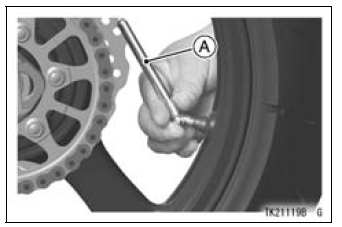

Failure to maintain proper inflation pressures or observe payload limits for your tires may adversely affect handling and performance of yourmotorcycle and can result in loss of control. The maximum recommended load in addition to vehicle weight is 180 kg (397 lb), including rider, passenger, baggage, and accessories.
NOTE

A. Tire Pressure Gauge
Tire Air Pressure (when cold)

 Wheels
Wheels Tire Wear, Damage
Tire Wear, DamageShift Pedal Removal
Remove:
Shift Lever Bolt [A]
Front Footpeg Bracket Bolts [B]
If the tie-rod [C] is to be removed from the shift pedal and
the shift lever, loosen the tie-rod locknuts [D].
The front tie-rod locknut is left-hand thread.
Remove:
Shift Pedal Mounting Bolt [A]
...
Intake Air Temperature Sensor Removal
NOTICE
Never drop the intake air temperature sensor especially
on a hard surface. Such a shock to the sensor
can damage it.
Remove the fuel tank (see Fuel Tank Removal in the Fuel
System (DFI) chapter).
Disconnect the connector [A] from the intake air temperature
sensor.
Remove the da ...
Rear Master Cylinder Installation
Replace the washers that are on each side of hose fitting
with new ones.
Install the brake hose [A].
Touch the brake hose to the stopper [B] of the rear master
cylinder.
Tighten:
Torque - Brake Hose Banjo Bolt: 25 N·m (2.5 kgf·m, 18 ft·lb)
Install the master cylinder, the brack ...